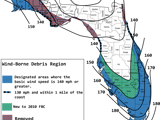Hurricane Rated Construction: Building Safe, Durable Structures for High-Wind Zones
For communities in hurricane-prone areas like Florida, the Gulf Coast, and the Southeast, having hurricane safe buildings is more than a precaution—it’s a necessity. Every year, tropical storms and hurricanes bring destructive wind speeds, heavy rainfall, and flooding that can devastate poorly prepared structures. Businesses, government agencies, and facility managers must prioritize hurricane construction methods that meet or exceed local codes while ensuring long-term durability.
This guide explores Florida hurricane building codes, wind load requirements, and how modular construction and hurricane-rated guard shacks offer reliable protection in severe weather zones.
Florida Hurricane Building Codes: A Benchmark for Safety
The Florida Building Code (FBC)
Florida is home to some of the strictest building regulations in the country, developed after decades of costly hurricane damage. The Florida Building Code (FBC) sets requirements for how structures must be designed, reinforced, and tested to resist hurricane-force winds.
-
Wind Load Ratings by Region: Florida is divided into zones based on expected wind speeds. For example:
-
Central Florida requires structures rated for 140–150 mph winds.
-
Coastal areas, including Miami-Dade and the Florida Keys, must withstand up to 180 mph winds, according to the Florida wind load map.
-
Nationwide Adoption: While designed for Florida, many coastal states reference or adapt the FBC because of its proven effectiveness in reducing storm damage.
Why Wind Load Ratings Matter
Wind load ratings measure the maximum force a building can withstand without structural failure. Without proper design, high winds can lift roofs, break windows, or collapse walls. By following the FBC, owners ensure their buildings remain safe, compliant, and insurable.
Beyond Wind: Flooding and Water Damage Protection
Hurricanes don’t only bring wind, they also bring storm surge and flooding. To design hurricane safe buildings, both threats must be addressed:
-
Elevated Foundations: Raising structures above flood level reduces the risk of water damage. Space beneath elevated buildings can double as storage or parking.
-
Flood-Resistant Materials: FEMA recommends materials like concrete, metal, or specific treated wood that can withstand wetting and drying cycles without losing strength.
-
Drainage Planning: Proper site grading, stormwater systems, and barriers help protect foundations and lower levels.
By combining wind resistance with water management strategies, facilities can better endure the full impact of a storm.
Hurricane-Rated Guard Shacks and Security Booths
Standard and Custom Wind Load Ratings
At Panel Built, our guard shacks rated for hurricanes are engineered to meet a variety of wind load requirements:
- Standard Units: Built to handle 90 mph winds, suitable for many inland areas.
- Reinforced Options: By adding steel channels inside panels, wind load resistance can be increased incrementally (about 10 mph per added channel).
- Welded Steel Guard Booths: Designed for maximum resilience, with thicker walls and structural reinforcements to meet Florida hurricane building codes and even the strictest regional requirements.
Real-World Example
A Panama City client needed elevated operator cabins for sensitive equipment, exposed directly to Gulf Coast storms. Panel Built delivered 7×15 modular control buildings with:
- 130 mph wind resistance
- Small missile impact-resistant windows
- Slanted viewing walls for visibility
- Forkliftable steel bases with diamond plate decking
These booths combined strength, practicality, and compliance for long-term performance in one of the nation’s most hurricane-prone areas.
Why Modular Construction Excels in Hurricane Zones
After Hurricane Andrew, FEMA’s review found that modular buildings outperformed many stick-built structures. The controlled factory process produces consistent, tightly constructed modules that resist wind damage.
Benefits of modular hurricane construction include:
-
Consistency: Built in factories with strict quality control, eliminating on-site variability.
-
Structural Rigidity: Module-to-module connections create inherently strong frames.
-
Faster Deployment: Prefabricated units can be delivered and installed quickly, which is critical for emergency response or recovery operations.
-
Proven Performance: FEMA concluded modular housing developments sustained “relatively minimal structural damage” compared to conventional framing.
Whether for guard shacks, offices, or equipment enclosures, modular construction offers a dependable path to hurricane resilience.
Key Takeaways
- Florida hurricane building codes set the national standard for storm-resistant construction.
- Designing for both wind and flooding ensures long-term safety and durability.
- Guard shacks rated for hurricanes from Panel Built can be customized to meet wind load requirements up to 180 mph.
- Modular construction has a proven track record for withstanding hurricane conditions.
Protect Your Facility with Hurricane-Safe Construction
When storms strike, the right building makes all the difference. Panel Built specializes in modular hurricane safe buildings, including guard shacks rated for hurricanes, offices, and custom enclosures that meet the toughest wind load and flood-resistance requirements.
Ready to protect your facility? Contact Panel Built today for a custom quote, or speak with our team about designing a hurricane-rated structure that meets your exact needs.





